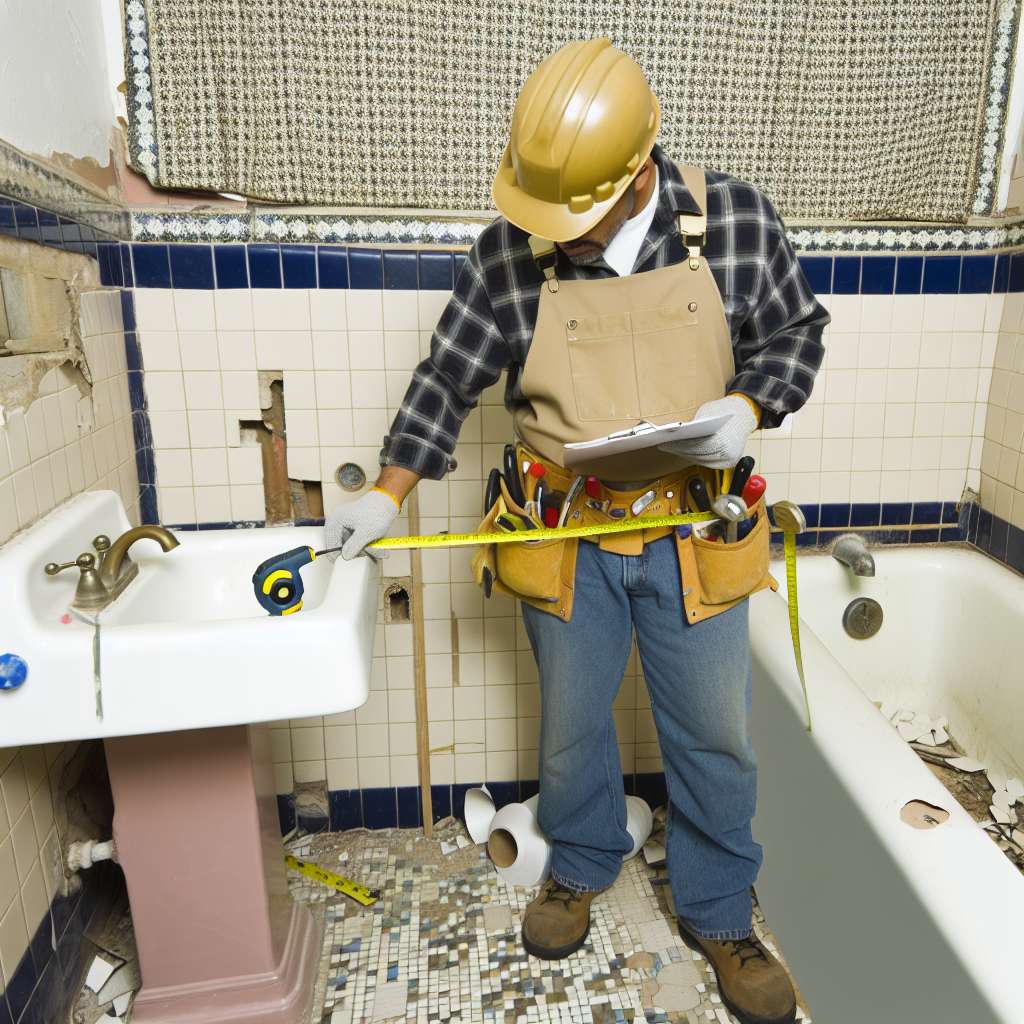Introduction to Bathroom Renovation
Importance of Renovating Your Bathroom
Renovating your bathroom enhances functionality and aesthetics.
An upgraded bathroom increases your home’s overall value.
It can improve energy efficiency through modern fixtures.
Furthermore, a fresh design promotes relaxation and comfort.
Benefits of a Bathroom Upgrade
Updated bathrooms provide a sense of luxury and style.
Upgrades can increase safety features, such as slip-resistant floors.
Modern amenities offer convenience and ease of use.
Sustainable materials reduce environmental impact and utility bills.
Considerations for Your Renovation
Begin by assessing your current bathroom layout and space.
Determine your budget and prioritize your needs accordingly.
Research design ideas to find inspiration for your vision.
Finally, consider hiring a professional for complex projects.
Factors Influencing Renovation Costs
Size of the Bathroom
The size of your bathroom significantly affects renovation costs.
Typically, larger spaces require more materials and labor.
Consequently, this can lead to higher overall expenses.
Transform Your Real Estate Decisions
Unlock personalized real estate insights crafted just for you. Get actionable advice designed to amplify your success.
Get StartedIn smaller bathrooms, you may find cost-saving opportunities.
However, compact designs might limit your renovation options.
Location of the Property
Your property’s location impacts material and labor availability.
Urban areas often have higher costs compared to rural settings.
For instance, cities may impose additional utility fees.
Moreover, local regulations can introduce extra expenses.
You should consider travel costs for different contractors as well.
Layout and Design Complexity
The existing layout influences both cost and complexity.
Simple renovations are usually more budget-friendly.
For example, keeping plumbing in place reduces costs.
Conversely, relocating fixtures incurs additional expenses.
A complex design may require custom features, raising costs further.
Quality of Materials
The choice of materials is a crucial factor in budgeting.
High-quality materials often come with a higher price tag.
Showcase Your Real Estate Business
Publish your company profile on our blog for just $200. Gain instant exposure and connect with a dedicated audience of real estate professionals and enthusiasts.
Publish Your ProfileHowever, investing in durable options may save money long-term.
Additionally, trendy materials may quickly go out of style.
It’s essential to balance aesthetics with practicality.
Labor Costs
Labor rates vary based on location and contractor experience.
Hiring skilled professionals tends to increase costs.
Nevertheless, their expertise can prevent costly mistakes.
Also, consider obtaining multiple quotes before making a decision.
Permits and Regulations
Renovations often require permits from local authorities.
These permits can introduce unexpected costs.
Staying compliant with building codes is essential for safety.
Neglecting permits may lead to fines or rework expenses.
Therefore, budget for these permits as part of your renovation costs.
Detailed Breakdown of Common Bathroom Upgrade Costs
Fixtures
Bathroom fixtures include essential items like faucets, sinks, and toilets.
These items play both a functional and aesthetic role in your renovation.
The cost for a new toilet typically ranges from $150 to $500.
Faucets can vary significantly, costing between $100 and $300.
Moreover, sinks generally range from $200 to $600 based on the style and material.
To ensure quality, consider investing in reputable brands.
High-quality fixtures bring durability and enhance your bathroom’s overall value.
Tiles
Tile selection is crucial for both style and functionality.
Popular materials include ceramic, porcelain, and natural stone.
Ceramic tiles usually cost between $1 and $15 per square foot.
Porcelain offers more durability, averaging $3 to $20 per square foot.
Natural stone tiles can be pricier, typically costing $5 to $30 per square foot.
Always factor in installation costs, which can range from $3 to $10 per square foot.
Choosing the right tile can significantly affect your renovation’s personality.
Labor
Labor costs form a significant portion of your renovation budget.
Hiring skilled professionals ensures quality workmanship throughout the project.
Labor rates commonly range from $50 to $150 per hour based on experience.
For a complete bathroom remodel, expect to pay between $1,200 and $3,000 for labor.
Showcase Your Real Estate Business
Publish your company profile on our blog for just $200. Gain instant exposure and connect with a dedicated audience of real estate professionals and enthusiasts.
Publish Your ProfileScheduling multiple tasks can help save on overall labor costs.
Consider using local contractors to compare rates and services effectively.
Ultimately, good labor investment leads to a successful renovation.
Explore Further: Breaking Down Essential Components Of Renovation Cost Estimation In The U.S.
DIY vs Professional Renovation: Cost Implications and Considerations
Assessing DIY Renovation Costs
DIY renovations can be an attractive option for many homeowners.
However, the costs can vary significantly based on personal skills and project complexity.
Materials and tools can add unexpected expenses to the overall budget.
Homeowners must also consider their time investment when taking on projects.
For example, a weekend project may stretch over multiple weeks if unforeseen issues arise.
Additionally, some tasks may require permits, which can increase costs.
In some cases, lack of experience can lead to costly mistakes.
However, DIY projects can also provide a rewarding experience and save on labor costs.
Understanding Professional Renovation Costs
Hiring a professional contractor ensures quality work and expertise.
However, it comes at a higher price compared to DIY efforts.
Labor costs are usually the most significant expense in a renovation project.
Contractors often include their markup on materials as well.
On the plus side, professionals can help avoid mistakes that may cost more in the long run.
Furthermore, they often have established relationships with suppliers to obtain better pricing on materials.
Getting an estimate from different contractors helps in understanding market rates.
Comparing Long-term Value
While DIY renovations may save money initially, consider long-term implications.
Quality work tends to increase property value significantly.
Professional craftsmanship generally assures that work meets building codes and standards.
In contrast, subpar DIY work could hinder future sale potential.
Homeowners should evaluate the balance between upfront costs and potential resale value.
Overall Considerations
Each renovation choice carries its pros and cons.
Consider personal skill level before deciding on a DIY project.
Assess the scope and complexity of your intended renovations.
Sometimes, a mix of both DIY and professional help delivers the best outcome.
Ultimately, thorough planning and a clear budget are essential for any renovation project.
Delve into the Subject: Luxury Home Upgrades That Elevate Indoor and Outdoor Living Spaces
Showcase Your Real Estate Business
Publish your company profile on our blog for just $200. Gain instant exposure and connect with a dedicated audience of real estate professionals and enthusiasts.
Publish Your ProfileBudgeting for Unexpected Expenses
Importance of Contingency Funds
Contingency funds are essential for any renovation project.
Unexpected expenses can arise during bathroom upgrades.
These expenses may include plumbing issues or structural repairs.
Having a contingency budget reduces financial stress.
It allows homeowners to address unexpected problems without panic.
Determining the Contingency Budget
Typically, setting aside 10-20% of the total budget is advisable.
This percentage provides a buffer for unforeseen costs.
Evaluate the complexity of your renovation to decide the amount.
For example, older homes may require more funds for repairs.
Common Unexpected Expenses
- Hidden water damage behind walls.
- Code violations that require updates.
- Unexpected plumbing or electrical issues.
- Increased material costs due to market fluctuations.
- Additional labor costs for unforeseen work.
Strategies to Manage Contingency Funds
Start with a detailed inspection of your bathroom.
Consider hiring a contractor for professional advice.
Communicate openly with your renovation team about potential issues.
Review and adjust your budget periodically throughout the project.
This ensures you remain prepared for any surprises that may arise.
You Might Also Like: Renovation Cost Estimation for Homeowners on a Budget
Estimating Costs for Popular Upgrades
Showers
Upgrading your shower can significantly enhance your bathroom experience.
The cost of a shower upgrade varies based on the materials chosen.
Standard fiberglass units are typically less expensive than custom tile showers.
On average, expect to spend between $2,000 and $10,000 for a complete shower remodel.
Labor costs will also influence the final price.
Consider additional features like showerheads and fixtures for added luxury.
Choosing eco-friendly options can provide long-term savings.
Bathtubs
Bathtub upgrades can transform a bathroom’s ambiance.
The cost of upgrading a bathtub ranges widely based on style and material.
Standard models are generally less costly than freestanding or jetted tubs.
Installation can add significant costs, especially for complex designs.
Prices typically range from $1,500 to $15,000, depending on options selected.
Don’t forget to include the cost for any necessary plumbing changes.
Fixtures and finishes can enhance the overall aesthetic value.
Vanities
Vanities play a central role in bathroom functionality and design.
Showcase Your Real Estate Business
Publish your company profile on our blog for just $200. Gain instant exposure and connect with a dedicated audience of real estate professionals and enthusiasts.
Publish Your ProfileThe cost of vanities depends on size, material, and brand quality.
Ready-to-assemble options tend to be more affordable than custom builds.
Typically, you might spend between $500 and $5,000 on a vanity upgrade.
Consider countertop materials as they significantly affect your budget.
Remember to factor in installation costs and plumbing adjustments.
Accessories like sinks and faucets can also add to the total expense.
You Might Also Like: Renovation Cost Estimation for Luxury Home Upgrades

Financing Options for Bathroom Renovations
Exploring Loan Options
Loans provide immediate access to funds for renovations.
Many lenders offer specific home improvement loans.
Consider a personal loan for flexibility in usage.
Home equity loans can utilize your property’s value.
These loans often have lower interest rates.
Research different lenders to find competitive rates.
Understanding Grants and Assistance
Grants can help alleviate renovation costs.
Look for local government programs for financial aid.
Nonprofits sometimes offer renovation grants as well.
Check eligibility requirements before applying.
Grants don’t require repayment, making them valuable.
Utilizing Savings for Renovations
Savings can be a straightforward funding source.
A dedicated renovation savings account can help you budget.
Start early to accumulate enough for your project.
Consider setting up automatic contributions to this account.
Having savings can reduce reliance on loans.
Combining Financing Methods
Combine different financing options for flexibility.
Mix loans and savings to cover total costs effectively.
This approach can minimize monthly payments.
Evaluate which combination suits your financial situation.
Consult a financial advisor for tailored advice.
Cost-Effective Tips to Reduce Renovation Expenses
Choosing Affordable Materials
Selecting the right materials helps you save significantly.
Research budget-friendly options without sacrificing quality.
Showcase Your Real Estate Business
Publish your company profile on our blog for just $200. Gain instant exposure and connect with a dedicated audience of real estate professionals and enthusiasts.
Publish Your ProfileConsider using ceramic tiles instead of high-end stone.
Vinyl flooring offers a stylish yet affordable solution.
Additionally, laminate countertops can mimic granite’s look for less.
Repurposing Existing Fixtures
Keep your current fixtures to trim costs substantially.
Refurbishing vanities can give them a fresh appearance.
Reusing sinks and bathtubs reduces both waste and expenses.
With creativity, you can modernize old fixtures easily.
DIY Labor When Possible
Consider doing some of the work yourself to save money.
Simple tasks like painting and installing fixtures are manageable.
Watch tutorial videos to gain confidence and skills.
However, hire professionals for complex plumbing or electrical work.
Planning for the Future
Invest in durable materials that can last many years.
Choose timeless styles that won’t go out of fashion quickly.
Proper planning can prevent costly errors down the road.
Set a realistic budget and stick to it to avoid overspending.
Shopping and Negotiating
Shop around for the best prices on materials and fixtures.
Visit multiple suppliers and compare prices before purchasing.
Don’t hesitate to negotiate prices or ask for discounts.
Sometimes, bulk purchases can lead to additional savings.
Planning for a Successful Bathroom Renovation Within Budget
Effective planning is essential for a successful bathroom renovation.
Begin by defining your renovation goals clearly.
Consider how you want the space to function and look.
Next, create a realistic budget for your project.
Research common costs associated with bathroom upgrades.
Identify the features that are necessary versus those that are optional.
Estimating Renovation Costs
Collect estimates from multiple contractors for comparison.
Look into the costs of materials needed for the upgrades.
Factor in additional expenses like permits and inspections.
Include a buffer for unexpected expenses that may arise.
Setting Priorities
Prioritize the most critical aspects of your renovation.
Showcase Your Real Estate Business
Publish your company profile on our blog for just $200. Gain instant exposure and connect with a dedicated audience of real estate professionals and enthusiasts.
Publish Your ProfileFocus on elements that enhance functionality and aesthetics.
Think about the long-term benefits of quality investments.
This approach helps prevent overspending on less important upgrades.
Monitoring Expenses During the Renovation
Keep a detailed log of all renovation expenses as they occur.
This will help you track your budget effectively.
Adjust your plans if you start to exceed your budget limit.
Communicate regularly with your contractors about costs.
Staying Flexible
Remain open to adjustments throughout the renovation process.
Be prepared to alter plans based on contractor feedback or cost changes.
Flexibility can lead to better decisions and overall satisfaction.
Creating Your Ideal Bathroom Space
Careful planning leads to successful bathroom renovations.
With a clearly defined budget and flexibility, you can achieve your ideal space.
Focus on creating a bathroom that meets your needs and fits your style.
Additional Resources
What is a fair price to remodel a full bathroom? : r/Remodel




